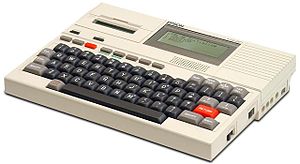The I.B.M. SCAMP project (Special Computer APL Machine Portable), was demonstrated in 1973. This prototype was based on the PALM processor (Put All Logic In Microcode).
The I.B.M. 5100, the first commercially available portable computer, appeared in September 1975, and was based on the SCAMP prototype.
As 8-bit CPU machines became widely accepted, the number of portables increased rapidly. The Osborne 1 used the Zilog Z80, weighed 23.5 pounds (10.7 kg). It had no battery, only a tiny 5" CRT screen and dual 5¼" single-density floppy drives. In the same year the first laptop-sized portable computer, the Epson HX-20, was announced[10]. The Epson had a LCD screen, a rechargeable battery and a calculator-size printer in a 1.6 kg (4 pounds) chassis. Both Tandy/Radio Shack and HP also produced portable computers of varying designs during this period.
The first laptop using the clamshell design, used today by almost all laptops, appeared in 1982. The $8150 GRiD Compass 1100 was used at NASA and by the military among others. The Gavilan SC, released in 1983, was the first notebook marketed using the term "laptop".
From 1983 onwards:
- Several new input techniques were developed and included in laptops: the touchpad (Gavilan SC, 1983), the pointing stick (IBM ThinkPad 700, 1992) and handwriting recognition (Linus Write-Top[11], 1987).
- Some CPUs were designed specifically for low power use (including laptops (Intel i386SL, 1990), and were supported by dynamic power management features (Intel SpeedStep and AMD PowerNow!) in some designs.
- Displays reached VGA resolution by 1988 (Compaq SLT 286) and 256-color screens by 1993 (PowerBook 165c), progressing quickly to millions of colors and high resolutions.
- High-capacity hard drives and optical storage (CD-ROM followed CD-R and CD-RW and eventually by DVD-ROM and the writable varieties) became available in laptops soon after their introduction to the desktops.
Early laptops often had proprietary and incompatible system architectures, operating systems, and bundled applications, making third party hardware and software difficult and sometimes impossible to develop.



0 comments:
Post a Comment